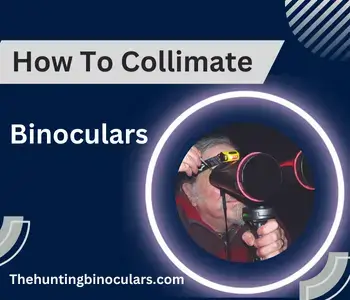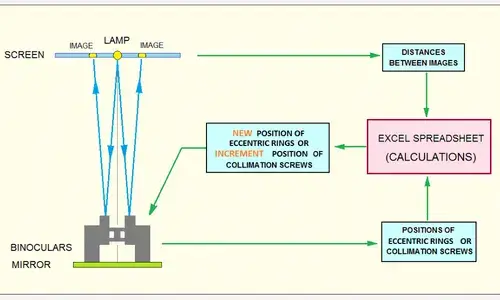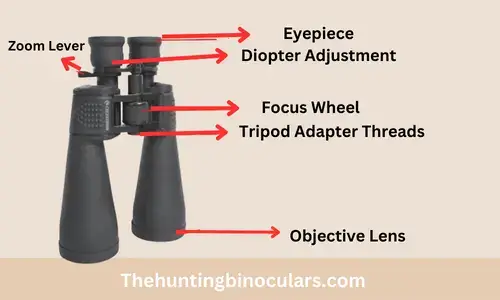
Collimation is the process of aligning the optical elements of a binocular to ensure that both eyepieces are in perfect synchrony, delivering a crisp and sharp image. A well-collimated set of binoculars results in better image clarity, improved light transmission, and a better viewing experience overall. How to collimate binoculars?
To collimate binoculars, first, adjust the focus on both barrels of the binoculars to the same level. Next, adjust the interpapillary distance to match the width of your eyes. Then, look at a distant object through the binoculars and adjust the screws or knobs located near the eyepiece until the two images merge into one. Finally, check the collimation by observing a few objects at different distances.
In this article, we’ll discuss the steps involved in collimating binoculars, including the tools and techniques required, to help you get the most out of your binoculars.
Table of Contents
How to Collimate Binoculars-Everything You Need to Know
Binocular collimation is the process of adjusting the alignment of the two optical tubes so that they work together as a pair, and you see a single, clear image. Does almost everyone know what are binoculars used for? Here’s a step-by-step guide on how to collimate binoculars:
Find a bright object to focus on
A distant object such as a light post, a distant tree, or a bright star can be used to collimate your binoculars. Make sure that the object is in clear view and is brightly lit for this purpose you should know what are the strongest binoculars.
Focus on each eyepiece separately
Adjust each eyepiece individually so that they are in focus. Close your right eye and adjust the left eyepiece until the object is in focus. Next, close your left eye and adjust the right eyepiece until the object is in focus. Repeat this process until the image is clear and sharp in both eyes.
Set the IPD (Interpupillary Distance)
This is the distance between your eyes, and you need to adjust your binoculars to match your IPD. Hold your binoculars up to your face and adjust the distance between the two barrels until you see a single, clear circle.
Adjust the diopter
Look through the binoculars with both eyes open and focus on the distant object. While keeping the object in view, close your right eye and adjust the diopter on the left eyepiece until the object is in sharp focus.
Next, close your left eye and adjust the diopter on the right eyepiece until the object is in sharp focus. The diopter adjustment only needs to be done once, and after that, you should be able to focus both eyepieces together.
Check for alignment
Look through the binoculars with both eyes open and focus on the distant object. If the image appears blurry or double, you need to adjust the alignment. Hold the binoculars steady and use the adjustment screws on the hinges to align the two tubes. Turn the screws slowly and carefully until you see a single, clear image.
Test your binoculars
Look at different objects at different distances to ensure that your binoculars are collimated correctly. If you notice any issues with the image, repeat the process until you achieve the desired collimated binoculars.

How to Collimate Binoculars Skymaster
Collimation refers to the alignment of the optical elements within a binocular. Misaligned optics can result in blurry or double images, making the binoculars difficult or impossible to use. Here are the steps to collimate Skymaster binoculars:
- Set up your binoculars on a sturdy tripod or mount. This will ensure that they are stable during the collimation process.
- Identify the collimation screws. Skymaster binoculars have two screws on each side of the binoculars, located on the prism housing. These screws are typically covered with a plastic or rubber cap.
- Remove the caps from the collimation screws. You may need to use a small tool like a screwdriver or a coin to do this.
- Look through the binoculars and focus on a distant object. It’s important to choose a faraway object that is stationary, like a building or a tree.
- Adjust the collimation screws. You will need to turn the screws in small increments, testing the focus after each adjustment. The goal is to align the prisms so that you see a single, clear image when looking through both eyepieces.
- Repeat the process for the other side of the binoculars. Adjust the collimation screws on the opposite side of the binoculars until you achieve a clear image when looking through both eyepieces.
- Once you have achieved proper collimation, replace the caps on the collimation screws.

Types of Collimation in Binoculars
There are two main types of collimation in binoculars: internal and external.
Internal Collimation
Internal collimation refers to the alignment of the optical components inside the binoculars, including the prisms, lenses, and mirrors. Internal collimation is usually done during the manufacturing process and is not adjustable by the user. However, some high-end binoculars may have adjustable internal collimation, which allows the user to make minor adjustments to the alignment.
External Collimation
External collimation refers to the alignment of the two sides of the binoculars, which is adjustable by the user. External collimation is usually done using screws or other adjustment mechanisms located on the outside of the binoculars. The user can adjust the alignment of the binoculars until they see a single, clear image.
Other Types of Collimation in Binoculars
Horizontal Collimation
Horizontal collimation is a process used in radiology to ensure that the X-ray beam is confined to a specific area, usually the area of interest. The horizontal collimator is a piece of equipment that is fitted to the X-ray machine and is used to control the spread of the X-ray beam in the horizontal plane.
Horizontal collimation is important because it helps to reduce unnecessary radiation exposure to the patient and the radiologic technologist. By eliminating unnecessary radiation, the quality of the image is also improved, making it easier to detect abnormalities and diagnose patients accurately.
Vertical Collimation
Vertical collimation is the alignment of the X-ray beam in the vertical direction. It refers to the process of adjusting the height or position of the X-ray tube so that the beam is aimed correctly at the patient’s anatomy. Vertical collimation is important for obtaining accurate and clear X-ray images to aid in clinical diagnosis.
It helps prevent scatter radiation from reaching the image receptor, which can lead to decreased image clarity and increased radiation exposure to the patient. Proper vertical collimation also ensures that the entire area of interest is included in the X-ray image, minimizing the need for retakes and reducing patient discomfort.
Importance of Collimation in Binoculars
What is collimate? Collimation is an essential process that greatly impacts the performance, comfort, durability, and user experience of binoculars. Proper collimation can improve image quality, provide comfortable viewing, increase durability, and enhance the user experience, making it an important consideration when selecting and maintaining binoculars.
Improved Image Quality
Collimation ensures that the images seen through each eyepiece are aligned, which results in a sharp, clear, and properly focused image. Misaligned binoculars can cause double images, blurred vision, and reduced sharpness, making it difficult to get a clear view of the target.
Comfortable Viewing
Properly collimated binoculars provide comfortable viewing for extended periods. Poor collimation can cause eye strain, headaches, and other discomforts, which can make it difficult to use binoculars for extended periods.
Increased Durability
Collimation can help increase the longevity of your binoculars. Misaligned binoculars can put stress on the internal components, leading to damage over time. Proper collimation ensures that the optical components are properly aligned, reducing stress on the internal parts and increasing the lifespan of your binoculars.
Enhanced User Experience
Collimation can greatly enhance the user experience of using binoculars. Properly collimated binoculars make it easier to view and track moving targets, such as birds or wildlife, with precision and accuracy.
Tips on How to Maintain the Collimation
How to collimate roof prism binoculars to keep them protected? Proper maintenance of the collimation of your binoculars is crucial to ensure that they perform optimally and provide clear and sharp images. Here are some tips on how to maintain the collimation in binoculars:
Store your binoculars properly
When not in use, store your binoculars in a protective case or pouch to prevent any damage to the internal components. Avoid storing them in extreme temperatures or humid environments.
Avoid dropping or knocking your binoculars
Dropping or knocking your binoculars can cause misalignment of the internal components, affecting the collimation. Be careful when handling and carrying your binoculars to avoid any accidental impacts.
Clean the lenses and prisms regularly:
How to keep binoculars from fogging up? Dust, debris, and fingerprints on the lenses and prisms can affect the collimation of your binoculars. Clean the lenses and prisms regularly using a soft-bristled brush or a microfiber cloth to remove any dirt and smudges.
Check the collimation regularly
Check the collimation of your binoculars regularly by observing a distant object with both eyes and adjusting the focus until you see a single, clear image. If you notice any double images or misalignment, consider getting your binoculars collimated by a professional. Also, you should know how to choose binoculars for stargazing.
Avoid disassembling your binoculars
Disassembling your binoculars can cause irreparable damage to the internal components, affecting the collimation. Avoid trying to fix any issues yourself and consider taking your binoculars to a professional for any repairs or adjustments.
By following these tips, you can maintain the collimation of your binoculars and ensure that they provide clear, sharp, and comfortable viewing experiences for years to come with different binocular prism types.
FAQ’s
How do I know if my binoculars need collimation?
If you see two images instead of one when looking through your binoculars, the prisms may be out of alignment. If the images you see through your binoculars are not sharp or have a distorted appearance, it could indicate a collimation issue. If one side of your binoculars is in focus, but the other side is not, it could be due to collimation issues.
How to collimate Bushnell binoculars?
To collimate your Bushnell binoculars, start by taking them apart and removing the objective lens. You can do this by unscrewing it from the eyepiece. Now, place the objective lens on a flat surface and place the eyepiece in front of it. Hold the eyepiece with one hand and use your other hand to hold the objective lens. Now, with your dominant hand, turn the eyepiece in a counter-clockwise motion so that it is lined up with the objective lens.
How to collimate CelestronSkymaster 15×70 binoculars?
The CelestronSkymaster 15×70 binoculars are a great pair of binoculars to use in the night sky. They are lightweight and easy to use. These binoculars are not meant to be used during the daytime because they are not as bright as other binoculars. They can easily be adjusted by using the focus knob to ensure that your view is clear and crisp.
Conclusion
How to collimate binoculars? Collimating binoculars is a simple process that can be done by following some basic steps. The crucial part in collimating binoculars is to ensure that both the barrels are aligned correctly and the eyepieces are working in harmony.
For further questions and queries, you can visit the comment box. Thank you!
